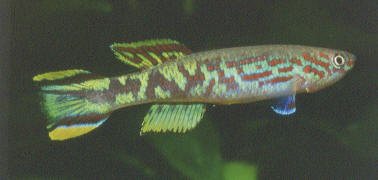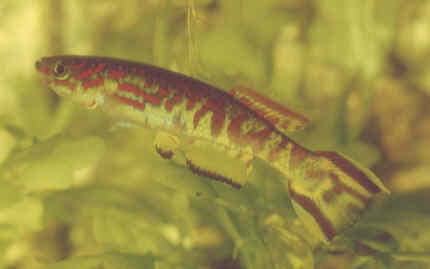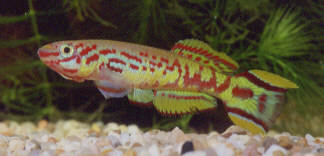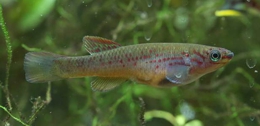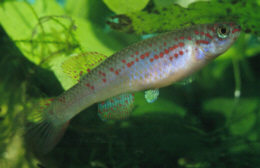Fundulopanchax spoorenbergi (Berkenkamp 1976)

Photo courtesy of Michael Pidwirny
| Meaning of Name |
After Frank Spoorenberg a Dutch aquarist who discovered them in an aquatic retailer. | ||||||
| First Description |
Berkenkenkamp H.O. 1976 (Aphyosemion spoorenbergi). Aphyosemion spoorenbergi spec. nov., ein neuer Prachtkärpfling aus dem Grenzgebiet von Nigeria, West-Kamerun. Aquarienfreunde 5 (7): p 123-138, figures, map. | ||||||
| Size |
7.5 cm | ||||||
| Meristics |
| ||||||
| Karyotype |
n = 19, A = 36 (Scheel 1975) | ||||||
| Sub-Genus |
Paraphyosemion | ||||||
| Group |
gardneri | ||||||
| Synonyms |
| ||||||
| Populations |
Fp.spoorenbergi. Photo courtesy of Ed Pürzl.
| ||||||
| Type Locality |
Unknown. Type material from commercial import. | ||||||
| Distribution |
Unknown but thought to inhabit the Nigeria / Cameroon border. | ||||||
| Habitat |
| ||||||
| Distinguishing Characteristics | Heavy red markings to the body. Sub marginal bands of red are also quite thick. | ||||||
| Colour/Pattern Variability | Low | ||||||
| History |
Discovered in a commercial import at Roelof's aquarium
fish importers, Amsterdam, Holland by F.Spoorenberg & P.Boelen, both members
of KFN in March 1974. Two different varieties were found which were called 'variety
A' & 'variety B'. The 'A' variety was more heavily marked & was bred &
distributed. The 'B' variety were possibly Fp.ndianus.
Mr.Rijff of Amsterdam succeeded in raising a few sterile specimens of the mirabilis cross. Berkenkamp received fish in May 1975 for study. | ||||||
| Breeding Notes |
Regarded as an easy species to breed. Eggs are laid on bottom mops. Water incubation takes around 3 weeks. If eggs are dried they take up to 6 months. Fry are capable of taking newly hatched brine shrimp as a first food. Growth is slow with sexual maturity taking 5-6 months. Berkenkamp wrote an article in BKA newsletter No.138, February 1977 with a breeding report. He found them easy to breed taking live & dried foods. Water temperature 21-23°C (higher temperatures were observed to shorten life span), pH below neutral. Water incubation of eggs took 14 days. Eggs dry stored in peat were wet in 21 days. Fry accepted newly hatched brine shrimp as a first food & growth was observed as being steady. Les McCathie in BKA Newsletter No. 266/267, October/November
1987 noted 40-50 eggs from one female in a 7 day period. Jaroslav Kadlec in BKA newsletter No.279, November
1988 noted that he has only had success with this sp. when water storing
the eggs. These hatch in 30-40 days at 24°C. | ||||||
| Diameter of Egg | |||||||
| Remarks |
Berkenkamp remarked that at 70 mm long caudal streamers
were developing in males. |
